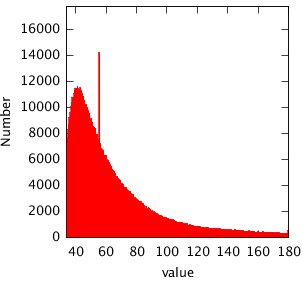 |
 |
| Figure 1a - Example of a W1 frame pixel histogram before the sky-offset "spike" fix. | Figure 1b - Pixel histogram for the same frame after the fix. |



In summary, the AllWISE multiframe pipeline used single-exposures from the 4-band cryo phase (all bands), the 3-band cryo phase (only W1 and W2) and the 2-band post-cryo phase (W1 and W2). The 2-band post-cryo single-exposures are the same as those included in the 2013 Post-Cryo Data Release. For 4-band and 3-band cryo, the single-exposures were reprocessed as described below. W3 from 3-band cryo was omitted from AllWISE processing due to rapidly varying temperatures and instrumental signatures throughout this period. The variations could not be adequately captured and removed by the instrumental calibrations.
The primary reason for reprocessing all single-exposures from the 4-band and 3-band cryo phases was the discovery of an instrumental calibration problem following the All-Sky (4-band cryo) Data Release. This had a severe impact on the faint-source photometry as described in section I.4.b.iv. of the All-Sky Explanatory Supplement. The calibration problem is known as the "histogram spike" effect and is tied to the initial computation of the dynamic sky-offsets.
The problem arised from including the actual frame on which the sky-offset was applied in the windowed frame-stack itself. This resulted in an excess of pixel values around the stack median in the final processed frame. This excess is discerned as a spike in the pixel histogram (see Figure 1a). Given a finite number of Nw frames in a window are stacked, a fraction 1/Nw of the pixels in the frame will inevitably equal the median exactly by chance. This is because the median will pick-out discrete values equal to one of the input measurements when the number of inputs is an odd integer. This anomaly was present throughout the 4-band and 3-band cryo single-exposure processing and caused local backgrounds to be overestimated during photometry. Consequently, this lead to photometeric fluxes being systematically underestimated in the All-Sky Data Release. The fix in AllWISE reprocessing was simply to omit the target frame from the input stack used to compute the sky-offset. The target frame being that frame where the sky-offset calibration was applied. Figure 1 shows an example of a W1 frame pixel histogram before and after the "spike" fix. Similar histogram spikes were seen in W2 and at a reduced level in W3 and W4.
The single-exposure reprocessing fixed another issue tied
to the dynamic calibration pipeline. The tagging of
bad-pixel transients
was not done optimally for the
All-Sky and 3-Band Cryo Data Releases. In the course of testing, it was discovered
that there was a potential to overestimate the number of dynamically
tagged bad pixels by a factor of 1.5 to 2. The impact on the
All-Sky and 3-Band Cryo Data Releases was that more pixels were masked than
necessary in downstream multiframe processing.
Bad pixel transients are now correctly masked from
co-addition
in the AllWISE multiframe pipeline.
 |
 |
| Figure 1a - Example of a W1 frame pixel histogram before the sky-offset "spike" fix. | Figure 1b - Pixel histogram for the same frame after the fix. |
During single-exposure reprocessing, we used the same calibrations and parameters as those in the 4-band and 3-band cryo processing phases. Due to runtime and the negligible impacts from modifications made to the instrumental calibration pipeline, the single-exposure uncertainty and bit-mask images were not regenerated. The same products from earlier processing phases (4-band and 3-band cryo) were used in the AllWISE multiframe pipeline. Furthermore, very little manual quality-assurance was performed on the new reprocessed frames. Only global trending analyses were performed. The same frame quality scores from earlier frame-level QA (for the All-Sky and 3-band Data Releases) were used to determine frame usability for the AllWISE muiltiframe pipeline. As a consequence, some "badly" calibrated frames (not captured by the original quality scoring) still made it through to the muiltiframe pipeline. An example is the existence of a number of W3 frames with "missing" (all-NaN'd) amplifier quadrants. This was due to an unexpected interplay of the new sky-offset calibrations with the droop correction.
Last update: 22 November 2013


